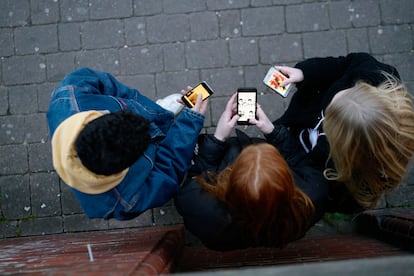72% of teenagers prefer to get information from a friend or family member rather than going to traditional media

60% of respondents, over 14 years old, get their information through social networks and in last place is the paper press, according to a report by Save The Children
Francesca Raffo Madrid. El Pais
Most teenagers prefer to turn to a friend or family member to find out what is happening around them, rather than using traditional media. According to the report Misinformation and hate speech in the digital environment, published this Thursday by Save The Children, 72% of teenagers over 14 years old do so in this way and 60% prefer to get their information on social networks . Radio and paper press are last in line.
Carmela Del Moral, co-author of the report and head of Childhood Policies at the NGO, explains that turning to someone close to them for information can have positive or negative effects. If the teenager turns to someone “with knowledge, who contrasts the information and has a critical vision, it can be a good source,” she says. However, “if we find ourselves in an environment that receives information in the same way [por redes sociales] and with few tools for contrast, it can be a problem,” she adds.
Means of access to information
Answers to the question: “What medium do you prefer to use to access information about things that happen around you?”
In %. Multiple choice
Family and/or friends
Girl Boy Total
79.6 65.5 72.6
Television
62.3 59.5 60.6
Social networks
63 58 60.2
Online press
30.1 34.2 32.1
Radio
7.6 10.7 9.4
Paper press
4.5 6 5.5
Source: Save The Children EL PAÍS

This last situation can be a chain of misinformation. For example, a teenager who consults a friend who, in turn, only gets information from social media, and so on. This can cause a difficulty, explains Del Moral, considering that one in four respondents does not verify information even if they suspect it is false. And 68.6% believe that social media and content creators — such as YouTubers, TikTokers or streamers — can be trusted.
To reach these conclusions, Save the Children based its research on 3,315 adolescents aged 14 and over in Spain and five focus groups made up of 27 boys, girls and adolescents, with representation from ages 10 to 17.
“It is not that it is wrong for them to get information from social networks, because it is normal, the problem is when there is false information and teenagers are not able to verify it,” says Del Moral. The Internet and social networks thus become a double-edged sword, since false content and hate speech abound, the report indicates. Precisely this content is especially worrying because it is difficult to verify and deactivate it with data or real information. 40% of teenagers do not always know how to identify fake news, so they often validate this discourse, says the expert.
The latest two Reuters Institute Digital News Reports confirm this trend in young audiences: social media is replacing traditional media as primary sources of information. The reason is that they find it difficult to understand the language used by traditional media and their way of telling stories. It noted that 39% of young people between 18 and 24 years old use social media as their main source of news. In addition, the public pays more attention to celebrities and influencers than to journalists, even if it is related to a news story, on social media such as TikTok or Instagram.
Sexist, racist and sexist speeches
Respondents said they were immersed in content that promotes stereotypes related to race and sexuality. Many of the messages on social media have an aggressive and challenging tone , and are speeches that reinforce sexist, racist and homophobic positions .
One of the teenagers surveyed, aged 16, explained: “A girl in a bikini is going to get a lot more attention than a boy in a swimsuit, even if the boy is very handsome.” Another boy, aged 15, commented that a classmate posted a photo and received unpleasant comments such as “he was eating you up.” “It’s not very nice to be told that, especially if it’s a person you don’t even know,” added the teenager. In this sense, the report highlights that it is women who receive the messages in a more aggressive way. This interaction affects their emotional well-being and lowers their self-esteem and confidence. Other effects include the appearance of social demands regarding beauty and image control.






